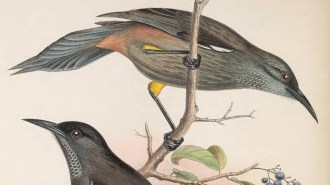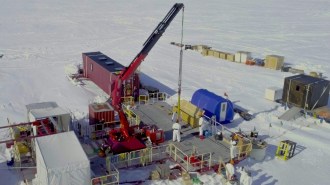Will Climate Change Depose Monarchs? Model predicts too-wet winter refuges
A computer analysis suggests that climate change could ruin the current Mexican overwintering sites for monarch butterflies and perhaps wipe out the insect’s populations in eastern North America.


While monarchs that summer in the western United States and Canada gather each autumn by the tens of thousands at spots along the California coast, east of the Rocky Mountains, monarchs head toward Mexico. Some 200 million of these butterflies flee cold weather to bask on about a dozen tree-covered mountain slopes in Mexico, explains Karen Oberhauser of the University of Minnesota at Minneapolis St. Paul.
A technique called ecological-niche modeling suggests that these sites will grow dangerously moist, increasing the chances of monarch-killing ice and snow, she and A. Townsend Peterson of the University of Kansas in Lawrence predict. The change could take place by 2050, the researchers say in the Nov. 25 Proceedings of the National Academy of Sciences.
The butterflies might change their winter destination, but will refuges with the required characteristics become available? “I think it’s really concerning,” says Oberhauser.
The new analysis is valuable because people might otherwise dismiss the impact of climate change on monarch butterflies and other long-distance travelers, says Chris Thomas of the University of Leeds in England, who also models climate effects on animals. “Because migrant species are so mobile, one might assume that they will be capable of responding to climate change immediately and easily, simply shifting their distributions into new areas,” he says.
Monarchs need a winter site that doesn’t freeze or get too warm. Migrating butterflies have immature reproductive systems. “They’re like 11-year-old kids,” Oberhauser says. High temperatures might prematurely kick the monarchs’ development into gear while they’re still overwintering. Without the milkweed abundant farther north, they would miss their opportunity to reproduce.
Oberhauser and Peterson found climate data for Mexican areas that do and don’t support overwintering monarchs. The scientists fed some of the data into an ecological model that formulated the best rules for where the monarchs winter. When tested on the rest of the real-world data, the rules worked well.
“This is the first time anyone has used niche modeling to look at the seasonal dynamics of a migratory species,” says Oberhauser.
The most important factors for the butterfly refuges turned out to be mean minimum January temperature and mean January precipitation.
Next, the researchers consulted detailed climate predictions from the Hadley Center in Exeter, England. Under both a conservative and a more dramatic scenario, the rules predict that the temperatures at the sites will fall within the butterflies’ tolerance. However, in both conditions, precipitation will more than triple by 2050, moving far beyond the amount that overwintering monarchs are known to survive.
Because monarchs have four or five generations per year, people can’t just move the monarchs to new winter locations and expect them to return. It’s their great-great-grandchildren that will migrate south next year.
The species does have some flexibility, Oberhauser points out, since it’s already expanded its range from North America to other continents.
****************
If you have a comment on this article that you would like considered for publication in Science News, send it to editors@sciencenews.org. Please include your name and location.
To subscribe to Science News (print), go to https://www.kable.com/pub/scnw/
subServices.asp.
To sign up for the free weekly e-LETTER from Science News, go to http://www.sciencenews.org/subscribe_form.asp.






